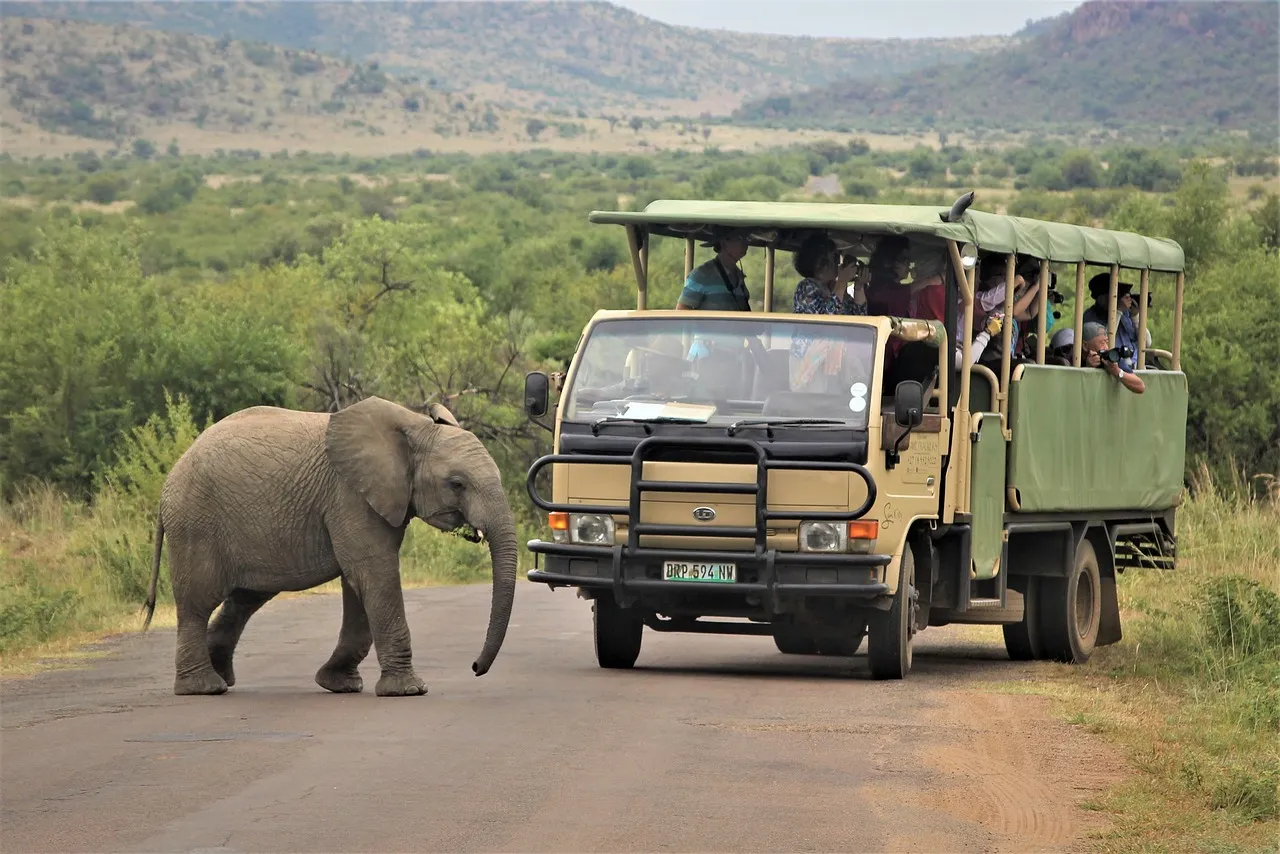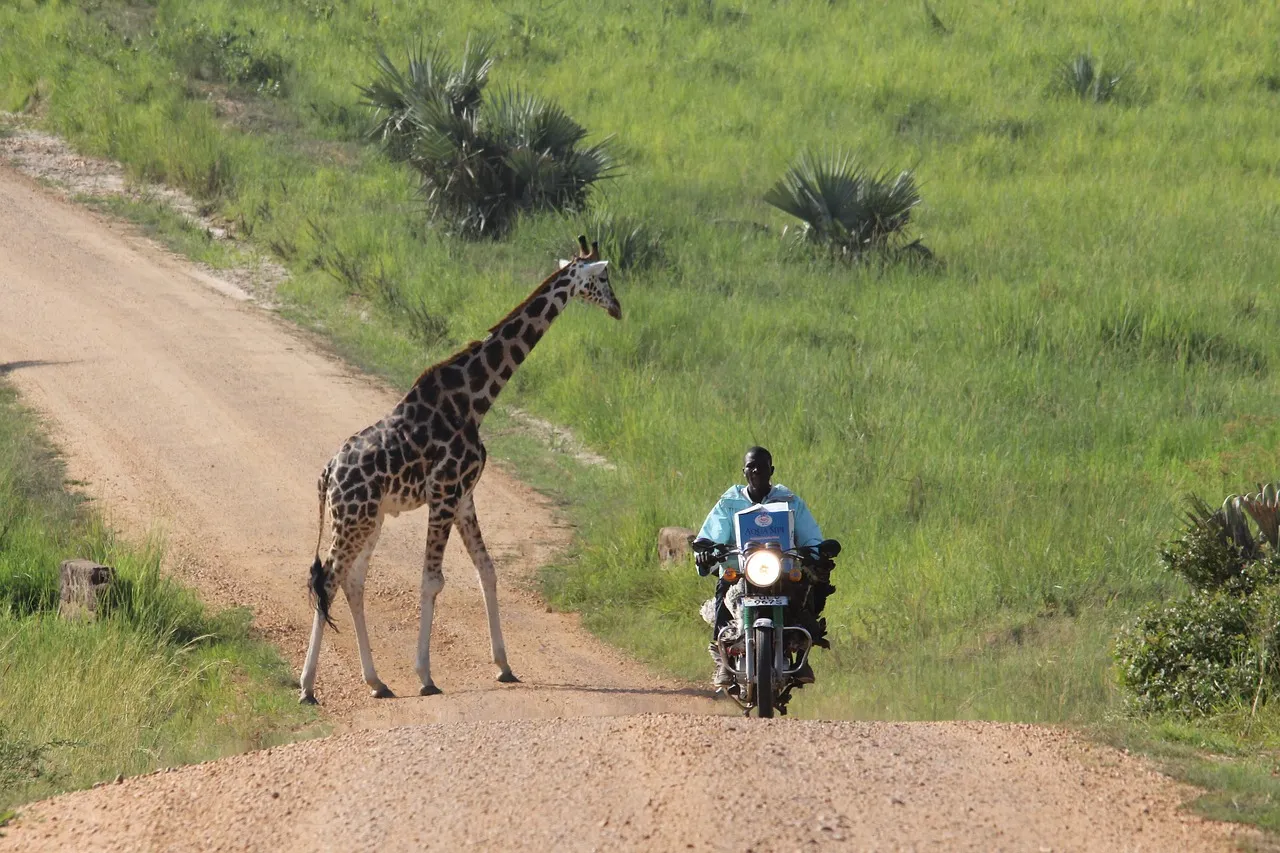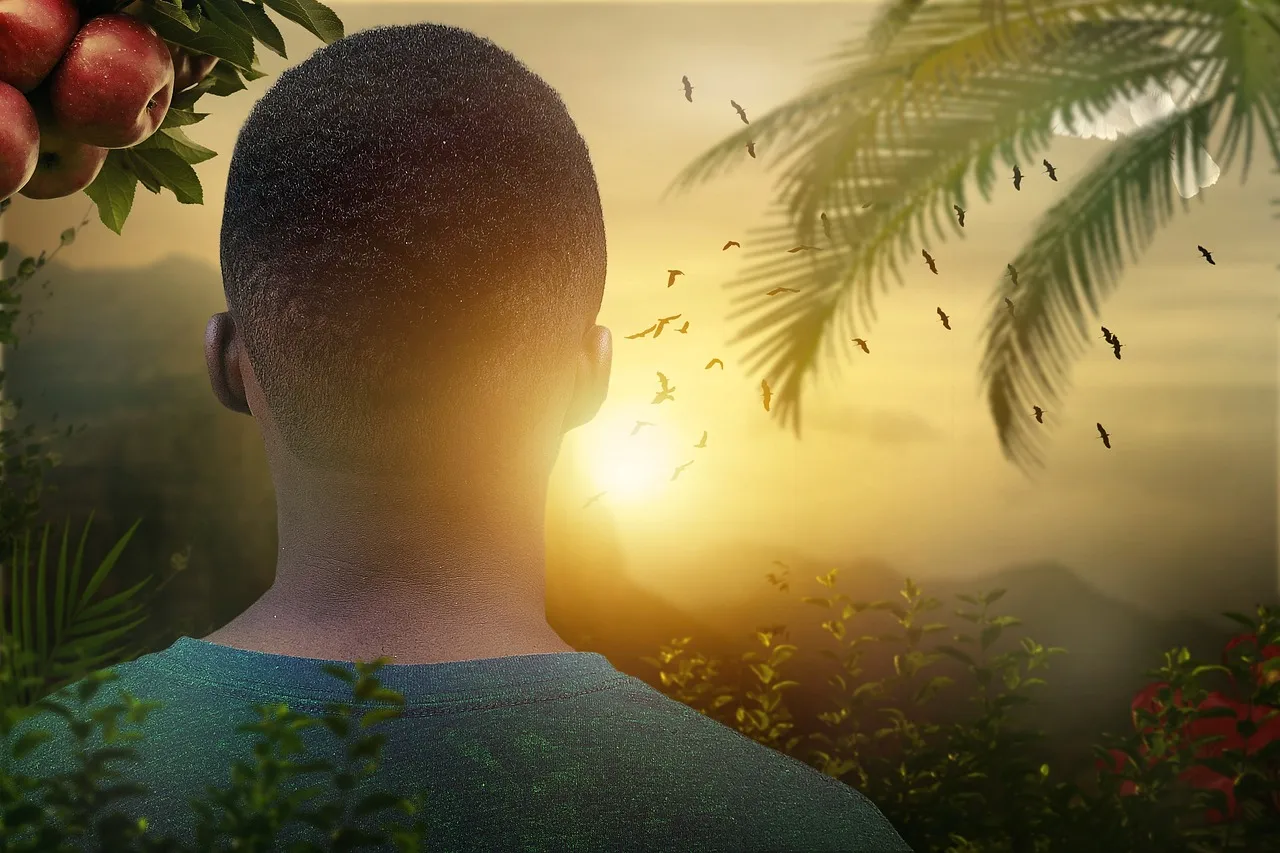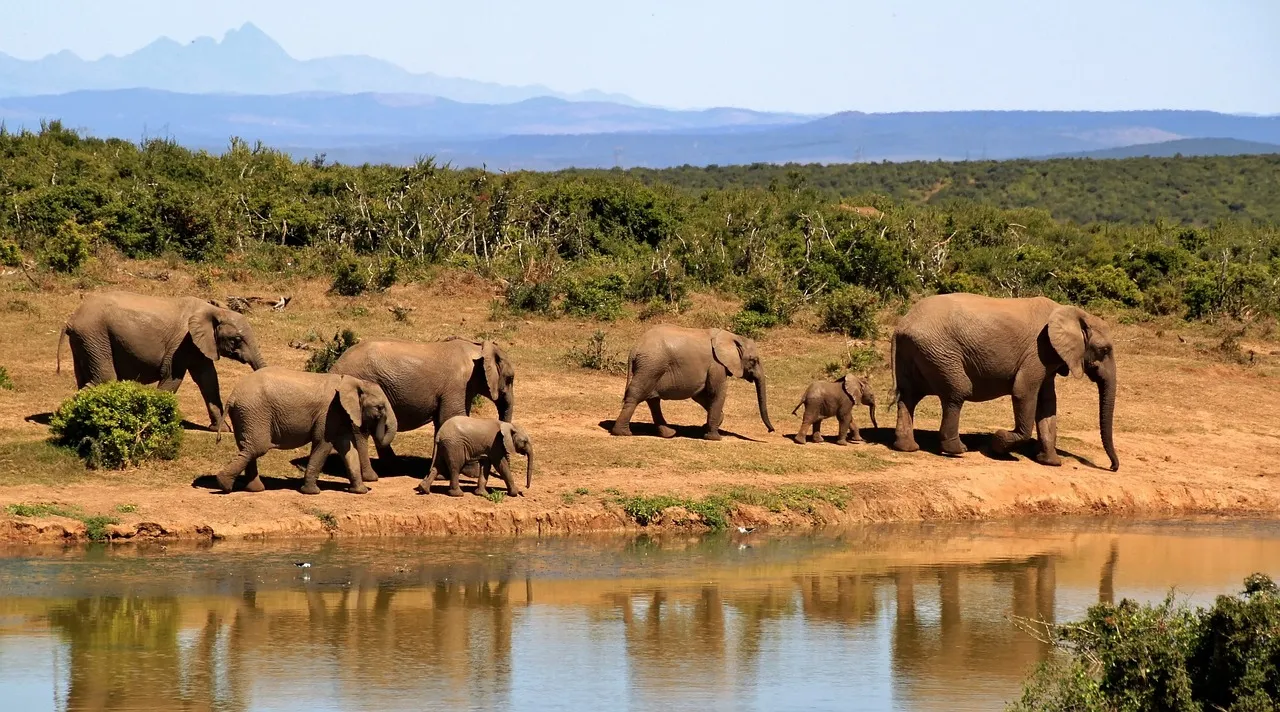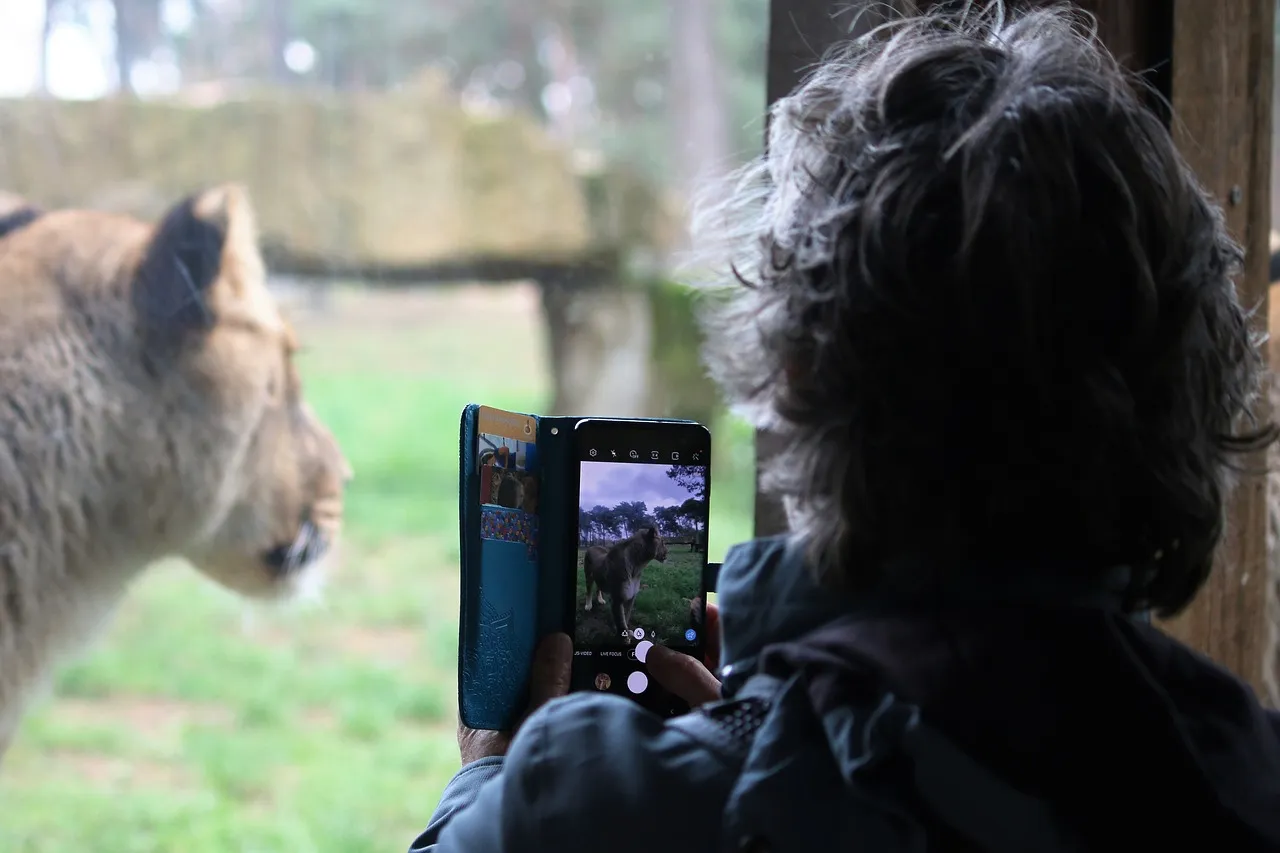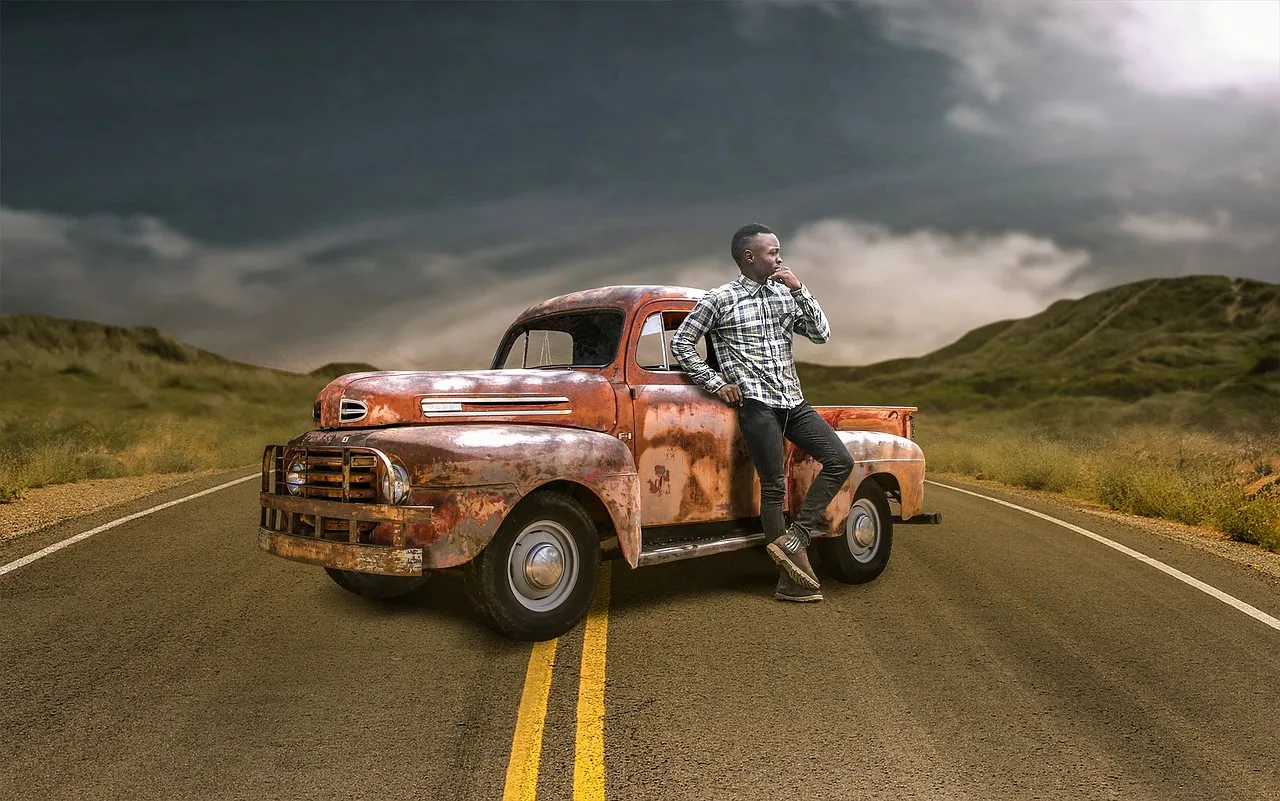Embarking on an African safari is like stepping into a living, breathing masterpiece painted by nature. The continent is adorned with wonders that captivate the soul and leave an indelible mark on those fortunate enough to witness them. In this blog post, we delve into the enchanting realm of African Safari Wonders, where wildlife roams freely, landscapes stretch endlessly, and every moment is a celebration of the raw beauty that defines Africa.
African Safari Wonders
1. Serengeti National Park, Tanzania: The Great Migration Spectacle
The Serengeti National Park in Tanzania stands as a testament to the untamed beauty of the African wilderness. The crown jewel of the park is undoubtedly the Great Migration – one of the most awe-inspiring wildlife spectacles on the planet. Witness millions of wildebeest, zebras, and gazelles traversing vast plains, crossing rivers teeming with crocodiles, and following the ancient rhythm of survival. The Serengeti is a living testament to the intricate dance of predator and prey, creating an unparalleled safari experience.
2. Okavango Delta, Botswana: The Jewel of the Kalahari
Nestled within the arid landscapes of the Kalahari Desert, the Okavango Delta in Botswana is a true oasis of life. As the largest inland delta in the world, it transforms the dry desert into a thriving ecosystem of waterways, lush islands, and diverse wildlife. Glide through the crystal-clear channels on a mokoro (traditional dugout canoe), witness elephants bathing in the waters, and encounter predators prowling through the grasslands. The Okavango Delta is a haven for those seeking an intimate and immersive safari experience.
3. Maasai Mara National Reserve, Kenya: The Land of Big Cats
Renowned for its staggering density of big cats, the Maasai Mara National Reserve in Kenya is a safari wonderland that draws wildlife enthusiasts from across the globe. The vast savannahs of the Mara provide a stage for the iconic African safari scenes – lion prides lazing in the shade, cheetahs sprinting across the plains, and leopards perched on acacia branches. Beyond the big cats, the Maasai Mara is home to the Great Wildebeest Migration and a rich tapestry of African wildlife.
4. Victoria Falls, Zambia/Zimbabwe: The Smoke That Thunders
While not a traditional wildlife safari destination, Victoria Falls is a natural wonder that demands inclusion for its sheer magnificence. Straddling the border between Zambia and Zimbabwe, this majestic waterfall is rightfully called “The Smoke That Thunders.” Witness the Zambezi River plunge into the Batoka Gorge, creating a spray that can be seen from miles away. The falls are surrounded by lush rainforests, offering a unique blend of adrenaline-pumping activities and serene natural beauty.
5. Ngorongoro Crater, Tanzania: The World’s Largest Unbroken Caldera
A wildlife haven and a geological marvel, the Ngorongoro Crater in Tanzania is a safari wonder that unfolds within the world’s largest unbroken caldera. Home to an incredible concentration of wildlife, including the densest population of lions in Africa, the crater provides a natural amphitheater for observing the interactions between predators and prey. As you descend into the crater, the landscapes reveal an ancient ecosystem where animals coexist in a delicate balance.
6. Kruger National Park, South Africa: A Biodiverse Safari Paradise
Stretching across nearly two million hectares, Kruger National Park in South Africa is a biodiversity hotspot and a sanctuary for a vast array of African wildlife. From the iconic Big Five – lion, elephant, buffalo, leopard, and rhinoceros – to a plethora of bird species and diverse ecosystems, Kruger offers a comprehensive safari experience. Embark on game drives, guided walks, or even hot air balloon safaris to immerse yourself in the richness of this wildlife haven.
7. Chobe National Park, Botswana: Riverfront Safari Extravaganza
For a unique safari experience, Chobe National Park in Botswana boasts a stunning riverfront setting along the Chobe River. This water-based safari allows visitors to witness massive herds of elephants bathing and playing along the riverbanks. The park is a mosaic of floodplains, woodlands, and savannahs, providing a diverse habitat for a wide range of African wildlife. Chobe is a prime destination for those seeking a safari that seamlessly combines land and water adventures.
An African safari is not just a journey into the heart of wildlife; it is a pilgrimage to the wonders that define the continent’s natural beauty. From the Great Migration in the Serengeti to the resplendent Victoria Falls, each destination offers a unique facet of Africa’s charm. Whether you seek the thrill of predator sightings or the serenity of a riverfront safari, the wonders of an African safari promise an experience that transcends the ordinary and lingers in the soul.
Best time for an African safari
Embarking on an African safari is a dream for many, and choosing the right time to experience this adventure is crucial for witnessing the diverse wildlife, stunning landscapes, and unique natural phenomena. In this comprehensive guide, we’ll explore the best times to plan your African safari, considering factors like weather, wildlife movements, and special events.
1. The Great Migration in East Africa: Witness the Spectacle
If witnessing the Great Migration is at the top of your safari bucket list, plan your visit to East Africa during specific months. The migration, involving millions of wildebeest, zebras, and gazelles, occurs between the Serengeti National Park in Tanzania and the Maasai Mara National Reserve in Kenya. The best time to catch this spectacle is from July to October when the herds cross the Mara River. This thrilling event is a true highlight of an East African safari.
2. Dry Season: Ideal for Game Viewing
For optimal game viewing, especially in Southern Africa, the dry season is the best time to plan your safari. In countries like Botswana, Namibia, and South Africa, the dry season typically spans from May to October. During this period, vegetation is sparse, and water sources become limited, concentrating wildlife around rivers and watering holes. The clear landscapes make it easier to spot animals, and the weather is generally more pleasant for outdoor activities.
3. Green Season: Lush Landscapes and Birthing Period
Contrary to the dry season, the green season, also known as the rainy or wet season, offers a different but equally enchanting safari experience. Occurring during the months of November to April in many regions, this period brings lush landscapes, vibrant flora, and a surge in animal activity. It’s an excellent time for birdwatching, and many species of migratory birds arrive. Moreover, the green season is the birthing period for many animals, leading to adorable sightings of baby animals.
4. Consider Shoulder Seasons for Ideal Weather and Fewer Crowds
The shoulder seasons, which fall between the dry and wet seasons, often provide a balance of favorable weather conditions and fewer crowds. These periods vary depending on the specific region, but generally, they occur during April to June and September to November. You can enjoy milder temperatures, witness the transition between seasons, and benefit from discounted rates on accommodations. Exploring during the shoulder seasons allows for a more intimate and serene safari experience.
5. Migration in Southern Africa: A Unique Perspective
While the Great Migration primarily occurs in East Africa, Southern Africa has its own version of this natural spectacle. In Zambia’s Liuwa Plain National Park, around November, wildebeest undertake their annual migration. This lesser-known migration provides a unique safari experience, and the park is less crowded compared to East African destinations. It’s an excellent option for those seeking a different perspective on the migration phenomenon.
6. Special Events: Plan Around Wildlife Activity
Consider planning your African safari around special wildlife events. For instance, in South Luangwa National Park, Zambia, the Emerald Season (green season) sees carmine bee-eaters nesting along the riverbanks, creating a stunning visual spectacle. Additionally, in the Kalahari Desert of Botswana, the Makgadikgadi Pans host one of the world’s largest zebra migrations from December to April. Research specific parks and reserves to discover unique wildlife events and plan your visit accordingly.
7. Cultural Festivals: Immerse Yourself in Local Traditions
To enhance your safari experience, consider attending cultural festivals that coincide with your visit. These events offer insights into local traditions, dances, and rituals. In Kenya, the Maasai Mara hosts the Maasai Olympics, promoting wildlife conservation and showcasing Maasai skills. Attendees can witness traditional ceremonies and interact with the Maasai community. Planning your safari around such events allows for a richer cultural experience.
Choosing the best time for an African safari involves balancing wildlife preferences, weather considerations, and personal preferences. Whether you aim to witness the Great Migration, experience the lushness of the green season, or explore during the shoulder seasons for ideal weather, Africa offers a diverse range of safari experiences throughout the year. Plan strategically, and you’ll be rewarded with unforgettable moments in the heart of the continent’s natural wonders.
Safari animals in Africa
Embarking on an African safari is a journey into the heart of the wild, where every turn may reveal a breathtaking spectacle of diverse and fascinating safari animals. In this guide, we delve into the enchanting world of Africa’s wildlife, from the iconic Big Five to the lesser-known marvels that contribute to the rich tapestry of the continent’s biodiversity.
1. The Big Five: Majestic Icons of the Safari
Elephant: The largest land mammal, the African elephant, is a symbol of strength and intelligence. Found in various ecosystems across the continent, these gentle giants graze on a variety of vegetation and can be observed in their family units during safaris.
Lion: Often referred to as the “King of the Jungle,” lions are apex predators with a majestic presence. Witnessing a pride lounging in the sun or observing a lioness on a hunt is a highlight of any safari experience.
Leopard: Known for their elusive nature and remarkable climbing abilities, leopards are expert hunters. Their spotted coat provides excellent camouflage in the diverse landscapes of Africa, making them a thrilling find on safari.
Buffalo: The African buffalo, also known as the Cape buffalo, roams grasslands and woodlands in large herds. Despite their seemingly docile appearance, buffaloes are known for their unpredictable behavior, adding an element of excitement to safari encounters.
Rhino: Both the black and white rhinoceroses contribute to the Big Five. Unfortunately, rhinos face threats from poaching, making them a conservation focus. Observing these magnificent creatures in their natural habitat is a poignant experience.
2. Giraffe: Graceful Giants of the Savannah
With their long necks and distinctive spotted coats, giraffes are among the most iconic safari animals. These gentle giants gracefully move through the savannah, using their height to reach the leaves of acacia trees. Witnessing a tower of giraffes against the African sunset is a sight to behold.
3. Cheetah: The Speedster of the Savannah
The cheetah, renowned for its incredible speed and slender build, is a masterful hunter. With their distinctive tear stripes and sleek form, cheetahs can sprint at remarkable speeds to catch their prey. Safari-goers may be fortunate enough to witness a cheetah in action during a hunt.
4. African Wild Dog: Endangered Beauty
African wild dogs, also known as painted dogs, are highly social and intelligent predators. Recognizable by their colorful coats, these dogs live in packs and exhibit cooperative hunting behaviors. The African wild dog is unfortunately endangered, making sightings of these unique creatures all the more special.
5. Hippopotamus: Behemoths of the Water
While often found submerged in rivers and lakes during the day, hippos emerge at night to graze on land. Despite their seemingly docile appearance, hippos are considered one of Africa’s most dangerous animals due to their territorial nature. Witnessing a group of hippos interacting in the water is a remarkable safari experience.
6. Zebra: Striped Wonders of the Plains
Zebras, with their distinctive black and white stripes, add a touch of vibrancy to the African savannah. These social animals often travel in herds and are known for their unique stripe patterns, which vary among species. Observing zebras graze or engage in playful interactions is a common delight on safari.
7. Nile Crocodile: Stealthy Predator of Waterways
Found in rivers and lakes across Africa, the Nile crocodile is a formidable predator with a reputation for stealth. These reptiles are known for their ability to patiently wait for prey near the water’s edge. Safaris near waterways provide opportunities to witness Nile crocodiles in their natural habitat.
8. Baboon: Animated Characters of the Bush
Baboons, with their expressive faces and animated behaviors, are often found in social groups known as troops. These intelligent primates are adaptable and can be observed foraging, grooming, and engaging in playful antics. Baboons add a touch of charm and liveliness to the safari experience.
An African safari is a profound journey into the heart of nature, where every encounter with safari animals is a testament to the continent’s incredible biodiversity. Whether tracking the majestic Big Five, observing the grace of giraffes, or marveling at the agility of cheetahs, each species contributes to the rich mosaic of Africa’s wildlife. Safaris offer a front-row seat to witness these wonders, creating memories that linger long after the adventure concludes.
Safari photography tips
Embarking on a safari adventure is a thrilling opportunity to capture the untamed beauty of Africa’s wildlife through your lens. Safari photography presents unique challenges and opportunities, requiring a combination of skill, preparation, and a keen eye for the extraordinary. In this guide, we’ll explore essential safari photography tips to ensure you return with stunning shots that tell the captivating story of your safari experience.
1. Choose the Right Gear: Gear Up for Success
Investing in the right photography gear is crucial for capturing the essence of the safari. Consider a camera with a telephoto lens to zoom in on distant wildlife. A DSLR or mirrorless camera with fast autofocus capabilities is ideal for capturing spontaneous moments. Don’t forget extra memory cards and batteries to avoid missing any remarkable shots.
2. Master Your Camera Settings: Be the Master of Your Craft
Familiarize yourself with your camera settings before embarking on the safari. Understand the basics of aperture, shutter speed, and ISO settings. In the dynamic environment of a safari, being able to quickly adjust these settings will make the difference between capturing a sharp image of a fast-moving cheetah and missing the shot.
3. Pack Essentials: Travel Light, Capture Right
While it’s tempting to bring all your photography equipment, consider the challenges of traveling in rugged safari vehicles. Opt for a versatile camera bag that is comfortable to carry and provides quick access to your gear. Essentials include lens cleaning kits, a sturdy tripod for low-light situations, and lens hoods to reduce glare.
4. Time Your Shots: Embrace the Golden Hours
The golden hours—early morning and late afternoon—offer soft, warm light that enhances the beauty of wildlife and landscapes. Animals are often more active during these times, providing ample opportunities for captivating shots. Plan your game drives around these golden hours to make the most of the magical lighting conditions.
5. Patience is Key: Wait for the Perfect Moment
Wildlife photography requires patience. Instead of chasing after animals, position yourself strategically and wait for the perfect moment to unfold. This might involve observing animal behavior, anticipating movements, and capturing authentic interactions. Patience often results in more compelling and natural shots.
6. Understand Animal Behavior: Predict and Capture
Study the behavior of the wildlife you encounter. Understanding animal habits allows you to predict their movements and actions, increasing your chances of capturing remarkable shots. Pay attention to signs of alertness, feeding patterns, and social interactions among the animals.
7. Experiment with Composition: Frame Your Story
Compose your shots thoughtfully to tell a visual story. Experiment with framing, rule of thirds, and leading lines to create visually appealing images. Don’t hesitate to zoom out occasionally to capture the vast landscapes that form the backdrop to your safari adventure.
8. Be Mindful of Noise: Stealth Mode Activated
In the quiet ambiance of the wilderness, the shutter sound of your camera can be intrusive. Switch your camera to silent mode or use a muffler to minimize noise. This ensures that your presence doesn’t disturb the natural behavior of the wildlife or your fellow safari-goers.
9. Capture Candid Moments: Embrace Authenticity
While posed shots can be beautiful, candid moments often convey the raw and authentic beauty of the wildlife. Capture animals in motion, engaging with each other, or exhibiting unique behaviors. These candid shots bring life to your safari photography portfolio.
10. Respect Wildlife: Ethical Photography Practices
Prioritize ethical photography practices to ensure the well-being of the animals and the sustainability of the safari environment. Maintain a respectful distance from the wildlife, avoid disrupting their natural behavior, and follow guidelines provided by your guides and conservation organizations.
Safari photography is a thrilling and rewarding pursuit that allows you to document the majesty of Africa’s wildlife. Armed with the right gear, knowledge of camera settings, and a patient approach, you can capture breathtaking moments that tell the story of your safari adventure. Embrace the challenges, savor the golden hours, and be prepared to be amazed by the remarkable images you can create in the heart of the wild. Happy shooting!
How to plan a safari trip
Embarking on a safari is a journey into the heart of the wild, offering unparalleled opportunities for capturing breathtaking moments of Africa’s majestic wildlife. Safari photography, however, comes with its own set of challenges and nuances. In this guide, we’ll explore essential tips to elevate your safari photography, ensuring you return with a portfolio of stunning and captivating shots.
1. Choose the Right Gear: Equip Yourself for Success
The foundation of great safari photography lies in the gear you choose. Opt for a camera with a telephoto lens to capture distant subjects and bring the wildlife up close. A DSLR or mirrorless camera with fast autofocus capabilities is essential for spontaneous moments. Ensure you have sufficient memory cards, extra batteries, and a sturdy camera bag for protection during bumpy rides.
2. Master Your Camera Settings: Take Control of Your Craft
Before embarking on your safari, familiarize yourself with your camera settings. Understanding aperture, shutter speed, and ISO will empower you to adapt quickly to changing conditions. Practice adjusting these settings effortlessly, as the ability to capture fast-paced wildlife moments hinges on your familiarity with your camera’s functionality.
3. Pack Light and Smart: Essentials for the Journey
While it’s tempting to bring all your photography equipment, safari travel demands a balance between being prepared and staying agile. Pack a versatile camera bag that provides quick access to your gear. Essentials include lens cleaning kits, a reliable tripod for stability in low-light conditions, and lens hoods to combat glare.
4. Time Your Shots: Embrace the Golden Hours
The golden hours, shortly after sunrise and before sunset, offer a soft, warm glow that enhances the beauty of both wildlife and landscapes. Plan your game drives during these times to take advantage of the magical lighting conditions. Not only does the golden light add a touch of enchantment to your photos, but animals are also often more active during these periods.
5. Patience is a Virtue: Wait for the Perfect Moment
Wildlife photography demands patience. Instead of chasing after animals, position yourself strategically and wait for the perfect moment to unfold. This might involve observing animal behavior, anticipating movements, and capturing authentic interactions. The patience invested often yields more compelling and natural shots.
6. Understand Animal Behavior: Predict and Capture
A deep understanding of animal behavior is a game-changer in safari photography. Take the time to study the habits of the wildlife you encounter. Recognizing signs of alertness, feeding patterns, and social interactions allows you to predict movements and capture the most captivating shots.
7. Experiment with Composition: Frame Your Safari Tale
Experiment with composition to tell a visually engaging story. Play with framing, utilize the rule of thirds, and incorporate leading lines to create dynamic and aesthetically pleasing images. Don’t shy away from occasionally zooming out to capture the vast landscapes that serve as the backdrop to your safari adventure.
8. Be Mindful of Noise: Silent Mode Activated
The serene ambiance of the wilderness demands a discreet approach to photography. Switch your camera to silent mode or use a muffler to minimize noise. This ensures that the shutter sound doesn’t disrupt the natural behavior of the wildlife or disturb the tranquility of the safari environment.
9. Capture Candid Moments: Embrace the Authentic
While posed shots have their charm, candid moments often convey the raw and authentic beauty of the wildlife. Capture animals in motion, engaging with each other, or exhibiting unique behaviors. Candid shots breathe life into your safari photography portfolio, offering a genuine glimpse into the wild.
10. Respect Wildlife: Ethical Photography Practices
Ethical photography practices are paramount in wildlife conservation and sustainable tourism. Maintain a respectful distance from the wildlife, avoid disrupting their natural behavior, and adhere to guidelines provided by your guides and conservation organizations. Prioritize the well-being of the animals and the preservation of their habitats.
Safari photography is a captivating blend of skill, patience, and an appreciation for the untamed beauty of the wild. By choosing the right gear, mastering your camera settings, and embracing the unique challenges of safari conditions, you can elevate your photography to new heights. Let the golden hours guide your lens, exercise patience in the presence of wildlife, and capture the authenticity of the safari experience through your camera. With these tips, your safari photography journey promises to be a rewarding and unforgettable adventure.
Luxury safaris in Africa
In the realm of travel experiences, few adventures match the splendor and exclusivity of luxury safaris in Africa. Imagine immersing yourself in the untamed beauty of the African wilderness while indulging in the finest accommodations, gourmet cuisine, and personalized service. In this guide, we unveil the allure of luxury safaris and explore the elements that make them an epitome of opulence and adventure.
1. Exquisite Accommodations: Wilderness Retreats in Style
Luxury safaris redefine the concept of accommodations, offering an array of opulent options that seamlessly blend with the natural surroundings. From lavish tented camps with private plunge pools to sumptuous lodges overlooking vast landscapes, every aspect of your stay is carefully curated for maximum comfort and exclusivity. Enjoy the intimacy of small, boutique camps or relish the grandeur of iconic lodges – the choice is yours.
2. Personalized Safari Itineraries: Your Adventure, Your Way
One of the hallmarks of luxury safaris is the flexibility and customization they offer. Tailored to your preferences, these itineraries ensure that every moment aligns with your desires. Whether you dream of witnessing the Great Migration, tracking the Big Five, or exploring remote and untouched landscapes, luxury safaris cater to your specific interests, providing a unique and personalized journey.
3. Expert Guides: Narrators of the Wilderness
Your safari experience is elevated by the presence of seasoned and knowledgeable guides who not only navigate the landscapes but also share profound insights into the flora and fauna that surround you. These guides, often local experts, possess an intimate understanding of the ecosystems, making each game drive an enlightening adventure. Expect riveting stories, fascinating facts, and a deep appreciation for Africa’s natural wonders.
4. Culinary Extravaganza: Gourmet Delights in the Bush
Luxury safaris extend the culinary journey beyond the savannah’s horizons. Indulge in gourmet meals prepared by skilled chefs who transform locally sourced ingredients into culinary masterpieces. Whether dining under the stars, in a private bush setting, or within the elegant confines of your camp, every meal is a celebration of flavors, complemented by fine wines and impeccable service.
5. Exclusive Wildlife Encounters: VIP Access to Nature’s Theater
Luxury safaris offer privileged access to prime wildlife viewing areas, ensuring that you witness Africa’s iconic species in their natural habitats without the crowds. Traverse private concessions, where the number of vehicles is limited, allowing for intimate and undisturbed encounters with the magnificent wildlife. Enjoy the luxury of time, enabling you to linger and savor each moment.
6. Spa and Wellness: Serenity in the Wilderness
After exhilarating game drives, retreat to the tranquility of luxury safari lodges that boast world-class spas and wellness facilities. Pamper yourself with rejuvenating treatments that draw inspiration from traditional African rituals. Surrounded by the sights and sounds of nature, these spa experiences elevate relaxation to an art form, allowing you to unwind in the lap of luxury.
7. Hot Air Balloon Safaris: Soaring Above the Serengeti
For an extraordinary perspective, many luxury safaris offer hot air balloon excursions that take you soaring above the sweeping landscapes of the African wilderness. Drift gracefully over the Serengeti or the Okavango Delta as the sun paints the sky in hues of gold. This airborne adventure provides a unique and awe-inspiring view of the vast expanses and the wildlife below.
8. Sustainable Luxury: Conservation at its Core
Many luxury safari operators are committed to sustainable tourism and conservation efforts. From eco-friendly lodges to community involvement initiatives, these safaris aim to minimize their environmental impact while contributing to the preservation of Africa’s unique ecosystems. Guests can actively participate in conservation projects, ensuring that their luxury experience leaves a positive footprint.
9. Private Villas and Retreats: Intimacy in the Wilderness
For those seeking the utmost exclusivity, luxury safaris often feature private villas and retreats within their expansive concessions. These secluded havens provide the perfect escape, offering privacy, personalized service, and uninterrupted views of the wilderness. Immerse yourself in the lap of luxury while surrounded by the sights and sounds of the African bush.
10. Seamless Transfers: Effortless Journeys between Paradises
Luxury safaris extend their opulence beyond the wild by orchestrating seamless transfers between destinations. Whether it’s a private charter flight, a scenic helicopter ride, or a stylish road transfer, the journey itself becomes part of the adventure. Travel with ease and comfort, knowing that every transition is designed to enhance your overall experience.
Luxury safaris in Africa are not merely journeys; they are symphonies of opulence, curated to immerse you in the grandeur of the continent’s wildlife and landscapes. From exquisite accommodations to personalized itineraries, each element is crafted to elevate your safari adventure to unparalleled heights of luxury. Indulge in the splendors of the African wilderness, where every moment is an invitation to savor the extraordinary.
